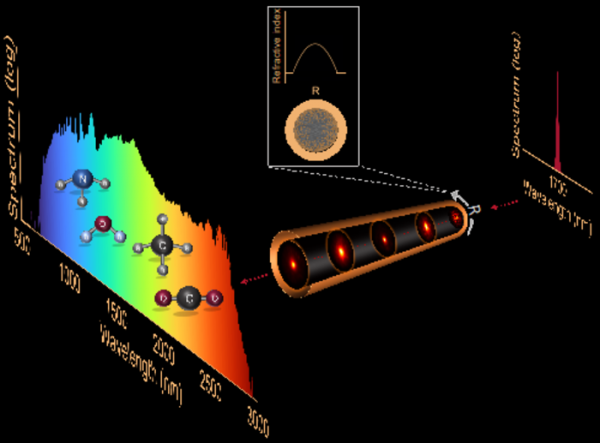Researchers at Tampere University have successfully developed a novel optical fiber design allowing the generation of rainbow laser light in the molecular fingerprint electromagnetic region. This new optical fiber with a self-cleaned beam can help in developing applications to, for example, tagging pollutants, cancer diagnostics, environmental monitoring, and food control. The finding was published in the prestigious journal Nature Communications.
When a high-power ultrashort pulse of light interacts with a material such as a glass optical fibre, a range of highly nonlinear interactions take place that cause complex changes in both the temporal and spectral properties of the injected light. When taken to the extreme, such interactions can lead to the generation of a rainbow laser of light commonly referred to as a supercontinuum light source. Since its first demonstration in a special type of optical fiber in 2000, supercontinuum laser light has revolutionized many areas of science, ranging from metrology and imaging at unprecedented resolution to ultrabroadband remote sensing and even the detection of exoplanets.
The current bottleneck with current supercontinuum sources, however, is that they are based on optical fibers that support a single transverse intensity profile or mode, which inherently limits their optical power. What’s more, conventional optical fibers are made of silica glass with transmission limited to the visible and near-infrared region of the spectrum. Extension of supercontinuum light to other wavelength regimes such the mid-infrared requires optical fibers made of so-called soft glasses, but these possess a lower damage threshold than silica, limiting even more the power of the supercontinuum beam.
Read more at Tampere University
Image: Utilizing two glasses with a different refractive index and stacked with a specific arrangement has allowed researchers to develop for the first time a multimodal fiber with a parabolic refractive index with transmission up to the mid-infrared and high nonlinearity. The spectrum of short pulses of light injected into the fiber massively broadens to span from the visible to mid-infrared. Significantly, unlike in conventional multimode fibers, the light beam remains smooth as the result of self-cleaning dynamics induced by the parabolic refractive index. Such a light source with ultrabroad spectrum, smooth beam and high power finds applications in e.g. environmental sensing or high-resolution imaging for medical diagnostics. (Credit: Tampere University)


